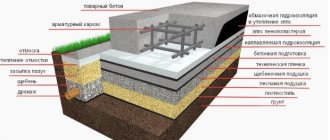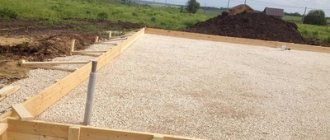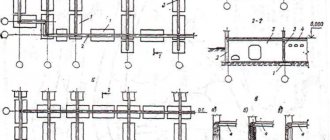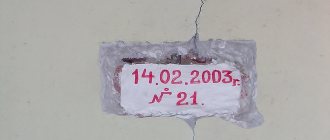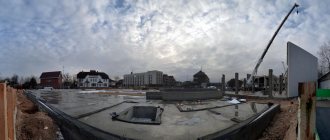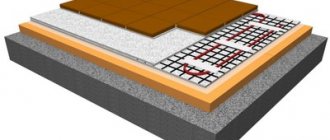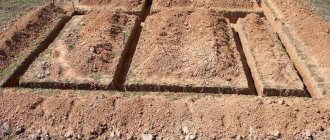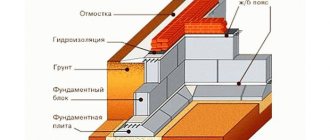Insulation of the foundation is done primarily in order to protect it from destruction due to temperature changes and moisture in the soil. This is especially true when building on wet clay soils. They try to insulate primarily the side walls of the foundation, and the base in rare cases and only when laying a shallow type of structure.
Is it worth insulating a monolithic slab base?
To achieve maximum energy efficiency of a structure, it is necessary to implement thermal insulation of the slab foundation both from below and along the perimeter of the structure.
In some cases, you can limit yourself to an insulated floor and basement, but when organizing an exploitable basement, thermal insulation of the base is a prerequisite to ensure a reduction in heat loss and comfortable living in the house.
Opinions for and against
Some practicing builders save money and refuse thermal insulation, justifying this by using concrete with low thermal conductivity or a high base. However, improving the insulating parameters of the design will simplify and make its operation cheaper.
So, insulation of a monolithic foundation slab:
- prevents destruction of concrete from temperature changes;
- makes it possible to save on heating the building;
- reduces the heaving of the soil under the building.
Only these three factors are enough to think about carrying out work. It should also be noted that with competent engineering design, it is possible to move the dew point beyond the contour of the main part of the building.
As a result, water will not accumulate inside the structure, which means that corrosion processes will not develop and conditions will not be created for the appearance of fungus and mold.
When it is necessary?
The issue of insulating slab foundations should be given special attention to residents of regions with difficult climatic conditions and deeply frozen soil. This zone occupies up to 80% of the entire territory of the Russian Federation.
Without high-quality insulation in the foundation structure, heaving soils at subzero temperatures will increase in volume and rise, violating the integrity of the reinforced concrete slab and causing cracks to appear in the walls of the structure itself.
Insulation of the foundation slab body
Warm concrete is used in many areas of construction. It can be purchased in the form of a ready-made mixture or manufactured at the construction site. For preparation, granulated polystyrene foam is added to the initial mixture to form the foundation slab.
Polystyrene concrete with a density of D1200 is used for constructing structural elements. When preparing 1 cube, the composition includes:
- 300 kg of cement M400;
- 1.1 m3 of polystyrene foam granules. It is better to use granular rather than crushed material. It has the shape of a ball, which leads to better envelopment with the cement mixture;
- 800 kg of sand;
- PAD. Often, saponified resin is added. Its presence in the composition ensures better adhesion and increases heat-shielding properties.
When creating such concrete, you need to remember about shrinkage. It is 1 mm per 1 m of surface. The slab needs to stand for some time after gaining strength. It is necessary to arrange a leveling screed on the surface.
The flammability class of such a product is G1. The concrete itself does not burn, but the insulation granules are exposed to fire. As a result, pores are created in the body of the foundation slab. They reduce the density of the structure and increase its moisture absorption.
The thermal conductivity of such a slab will be approximately 0.105 W/(m*C). The product requires additional insulation of the slab foundation from below. The thickness of the insulating material will be less, unlike plain concrete.
The choice of type and technology for insulating the foundation slab depends on the design features of the building and the construction site. Choosing the optimal solution is based on data from thermal engineering calculations and comparison of estimated costs.
Principles of thermal insulation of a concrete foundation structure
To prevent freezing of the slab foundation, insulation is laid both under the monolith and along the perimeter of the structure . Despite the waterproofness of the materials used, there are seams between the heat insulation boards, so they are attached to a layer of waterproofing material.
The use of mechanical fasteners is not allowed so as not to damage the structure of the heat insulator. Therefore, the slabs are fixed with glue or cement-sand mortar. The seams between prefabricated parts are filled with polyurethane foam or other composition that is suitable for its intended purpose.
If the thickness of the heat insulation slabs is not enough, the material is attached in several layers in a checkerboard pattern to avoid the formation of “cold bridges”. The result should be a seamless surface through which moisture cannot penetrate.
What materials can be used?
Despite the wide selection of thermal insulators (foam plastic, mineral wool, expanded polystyrene, etc.), not all raw materials offered by domestic and foreign manufacturers are suitable for foundations.
When choosing a material for its intended purpose, it is necessary to take into account the following characteristics:
- Low degree of thermal conductivity.
- Good moisture resistance.
- High compressive strength.
- Preservation of properties under conditions of sudden temperature changes.
- Resistance to aggressive environments.
The selected material must satisfy all of the listed requirements, since the heat insulator during operation is subject to vertical pressure from the structure, as well as loads from the external environment.
Which is better to choose and why?
Among the existing offers on the market, practicing builders choose in most cases extruded polystyrene foam (Penoplex) or polyurethane foam for thermal insulation of the foundation.
Advantages of extruded polystyrene foam:
- frost resistance;
- high moisture resistance;
- safety for human health and the environment;
- resistance to biological influences.
Another effective material, polyurethane foam, not only has thermal insulation qualities and does not allow moisture to pass through, but also suppresses noise, which is especially important when building near highways, railways and industrial facilities.
Polyurethane foam is sold in aerosol cans , which makes it possible to use it for external insulation of the vertical parts of a reinforced concrete slab.
Polystyrene foam and extruded polystyrene foam
Extruded polystyrene foam is widely used for insulating a monolithic foundation slab due, first of all, to its affordability. Essentially, this is the same foam plastic, but the difference in manufacturing technologies determined their different properties and thermal insulation characteristics.
The main advantage of extruded polystyrene foam is that, with a low specific gravity, it has high compressive strength. This property allows it to withstand significant static loads without undergoing deformation, and the porous structure of gas-filled closed cells determines its low thermal conductivity.
An undoubted advantage over polystyrene foam is the ability of extruded polystyrene foam to be minimally saturated with moisture, practically not allowing it to pass through. Polystyrene foam, due to its structure, has high water absorption, which is why it quickly loses its heat-insulating properties and becomes unusable, so its use as insulation for a foundation slab is undesirable.
How to insulate?
Before carrying out foundation work, an individual developer needs to prepare material, foam for sealing joints, as well as a tool for cutting slabs.
The heat insulation sheets must have the same thickness. When possible, slabs with stepped edges are used to ensure maximum contact of materials with each other. If the gap between the insulation parts exceeds 5 mm, it is sealed with polyurethane foam.
From below
To protect the base of the house from freezing from below, a layer of insulation can be laid in two ways:
- into the body of the foundation;
- on top of the stove.
In the first case, the bottom of the pit is carefully leveled and covered with geosynthetic material. A cushion made of non-metallic material is placed on top. To do this, sand and crushed stone are poured layer by layer onto geotextiles, moistened and compacted using special equipment.
Overlapping waterproofing material is laid on the pillow, securely fixing the seams with a soldering iron . A layer of heat insulation, usually made of penoplex, is mounted on top. It is convenient to work by joining the slabs using a locking system.
The seams are sealed with polyurethane foam. One of the next technological stages will be to lay the reinforcement cage and utility networks on the horizontal surface of the insulation.
Thermal insulation of a slab foundation can be carried out on top of the slab:
Waterproofing is installed on the monolith.- Logs are mounted on top.
- A layer of thermal insulation is laid between the joists.
- A waterproofing film is attached to the joists on top.
- Install a plank base as a subfloor.
Since penoplex has increased strength, in this case you can do without logs. The slabs are placed on the waterproofing layer with a continuous surface, a substrate is laid on top and a finishing coating is arranged.
Along the perimeter
Thermal insulation of the slab foundation along the perimeter can significantly reduce heat loss in the house . Insulation boards are installed in a vertical position along the inner perimeter of the board formwork.
If a knitted reinforcement frame is used for a monolithic slab, then a layer of waterproofing film is laid to protect the insulation from the liquid components of the concrete solution. When the reinforced frame is assembled by welding, a thin screed of low-grade concrete must be made on top of the waterproofing insulation.
The insulation can also be placed on a finished monolithic slab with already implemented waterproofing . The heat insulator is attached to the surface with glue or through melted bitumen. The means for fixing the materials is applied pointwise, and then the canvas is pressed tightly against the wall.
Thermal insulation of the base begins from below, laying out the parts first in a horizontal row. Each subsequent sheet is attached butt to the previous one.
Changing the position of the heat insulator two minutes after applying the fixing solution is not allowed!
Basic mistakes and ways to avoid them
Before taking on the design of a slab foundation, at the stage of developing thermal insulation measures, it will be useful for an individual developer to sort out typical mistakes.
Most often, novice builders choose raw materials for thermal insulation of the foundation based on their cost. Taking into account the loads to which the foundation will be subjected during operation, we can identify a number of unsuitable insulation materials for reinforced concrete foundation slabs:
Mineral wool does not have sufficient strength, rigidity and moisture resistance.- Expanded clay and other granular materials are characterized by high porosity and fragility, due to which liquid freely penetrates into the structure of the material.
- Polymer foam raw materials created directly on the construction site. To apply the method in foundation construction, the worker must have special skills.
- Foam plastic - despite low thermal conductivity and good moisture resistance, the material is characterized by weak compressive strength, as well as low resistance to mechanical damage.
If the soil on the site is not stable and heaving, then the slab is not laid at the level of the freezing point of the ground, as is the case with tapes or piles. This approach will lead to irrational consumption of building materials, and the efficiency of the heat insulator will decrease significantly.
In such a situation, the “floating” foundation technology is chosen, when the slab rises and falls along with the ground, without creating additional loads on the walls of the house.
The choice of insulation thickness is based on the design conditions of construction : the greater the load and the lower the ambient temperature, the denser and thicker the material should be. As a rule, the manufacturer of thermal insulators indicates recommended parameters on the packaging depending on the climatic conditions in the region.
A lot of important and useful information about the construction of a slab foundation is presented in this section.
Slab foundation insulation technology
The monolithic slab foundation has proven itself well when used in weak and heaving soils.
The annual freezing of soils in winter leads to uneven rise and settlement of the slab base, which contributes to the occurrence of mechanical deformations that can cause destruction of the slab itself and the building built on it. A layer of horizontal insulation can reliably isolate the foundation slab from the zone of frost heaving, contact with soil moisture and prevent freezing.
